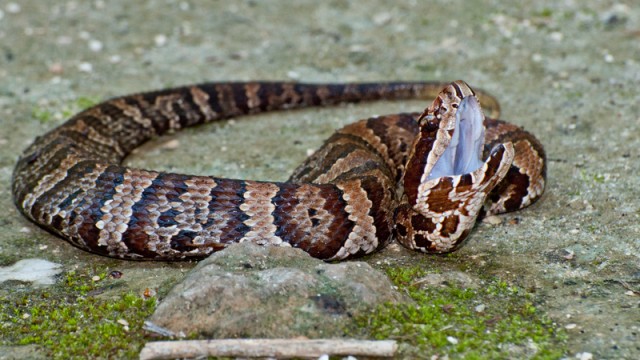One snake you should stay well away from, should you encounter it is the cottonmouth. These snakes are highly venomous, so do your best to memorize what this snake looks like and if you spot one you can run for the hills (or actually back slowly the hell away!).
The Smithsonian National Zoological Park tells us that cottonmouth snakes, also known as water moccasins, live in the southeastern U.S.. Their territory runs all the way from southern Virginia to Florida and to eastern Texas. Water moccasins swim in swamps, marshes, drainage ditches, and at the edges of ponds, lakes and streams, so in these regions, if you’re near water, be on the lookout!
2 – Cottonmouth
COTTONMOUTH (Agkistrodon piscivorus). Length 3-4 feet. Young cottonmouths are patterned quite like a wide-banded copperhead, but the colors are not so reddish. These snakes are always found in the vicinity of water. When approached they quite often hold their ground and open their mouths widely, revealing the white lining of the mouth, a habit which gives them their common name. This heavybodied snake is dangerously poisonous and, contrary to popular belief, can bite underwater.
Whereas the copperhead is a rather mild-mannered snake, the cottonmouth has a vicious disposition. Although nocturnal, it likes to sun-bathe, and it is frequently seen basking along shorelines, stretched out on low branches or upon the bank. Where this snake occurs, it is usually common.
Most people have never even heard of a massasauga snake? It’s the next venomous snake on our list and you’ll want to pay special attention on the Next Page so you can learn to identify it:


Yes Obama. Clinton,Schumer palosi. McCain, cnn
Well , they all look democRATS ,but they are so many of them it’s hard to identify them.
I can identify them only in soup or stews,they fast different .
#1 John mccain#2loretta lynch#3 Hillary clinton#4 jey johnson#6 Maxine Watters,#5obama#
Lynch,OBumer,Schumer ,Pelosie
–
Chuck Shumer
Nancy Pelosi
Elizabeth Warren
John McCain
Maxine Waters
Hillary Clinton
Nope
Guessing here…copperhead, water moccasin, and 2rattlesnakes…..one might be a sidewinder?
Dead snake!
The most important detail about snake bites is the statistic that the great majority of them occur because the victim tried to handle, or kill the snake. They’re easily as afraid of humans as we are them, so just leave them alone.